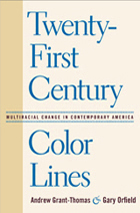
"The Closing Door is a crucial breath of fresh air . . . an important and timely text which will help to alter the 'underclass' debate in favor of reconsidering race-specific policies. Orfield and Ashkinaze construct a convincing argument with which those who favor 'race-neutrality' will have to contend. In readable prose they make a compelling case that economic growth is not enough."—Preston H. Smith II, Transition

The result of work initiated by the Harvard Civil Rights Project, this collection provides an excellent overview of the contemporary racial and ethnic terrain in the United States. The well-respected contributors to Twenty-First Century Color Lines combine theoretical and empirical perspectives, answering fundamental questions about the present and future of multiracialism in the United States: How are racial and ethnic identities promoted and defended across a spectrum of social, geopolitical and cultural contexts? What do two generations of demographic and social shifts around issues of race look like “on the ground?” What are the socio-cultural implications of changing demographics in the U.S.? And what do the answers to these questions portend for our multiracial future?
This illuminating book addresses issues of work, education, family life and nationality for different ethnic groups, including Asians and Latinos as well as African Americans and whites. Such diversity, gathered here in one volume, provides new perspectives on ethnicity in a society marked by profound racial transformations.
Contributors: Luis A. Avilés, Juan Carlos Martínez-Cruzado, Nilanjana Dasgupta, Christina Gómez, Gerald Gurin, Patricia Gurin, Anthony Kwame Harrison, Maria-Rosario Jackson, John Matlock, Nancy McArdle, John Mollenkopf, john a. powell, Doris Ramírez, David Roediger, Anayra Santory-Jorge, Jiannbin Lee Shiao, Mia H. Tuan, Katrina Wade-Golden and the editors.

With the greatest income inequality in the world, the nations of the Americas face the challenge of consolidating democratic regimes, improving productivity, and reducing poverty as they enter the twenty-first century. Educational opportunity is central to this threefold challenge.
The distinguished contributors to this volume discuss current policies and issues in Argentina, Chile, Colombia, Mexico, Peru, and the United States, as they explore the nature of the relationship among education, poverty, and inequality. The book provides impressive evidence linking school participation, the quality of education for poor children in the Americas, and the impact of education policies to promote social justice. Using both qualitative and quantitative data, the book addresses the following sets of questions: How does the education system reproduce social inequality? How does education provide opportunities for social mobility? What are the causal processes involved? What is the direction of this causation?
Linking theory and practice, the authors explore the dynamic relationship between educational change and social change, and weigh the significance of their findings for the educational chances of poor children.
READERS
Browse our collection.
PUBLISHERS
See BiblioVault's publisher services.
STUDENT SERVICES
Files for college accessibility offices.
UChicago Accessibility Resources
home | accessibility | search | about | contact us
BiblioVault ® 2001 - 2024
The University of Chicago Press









